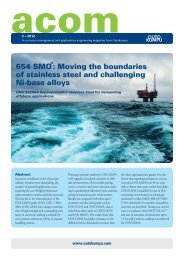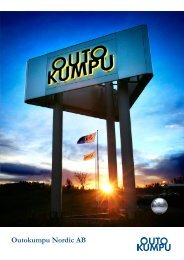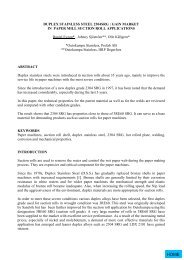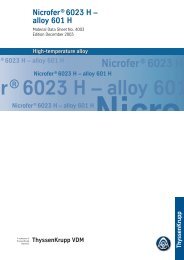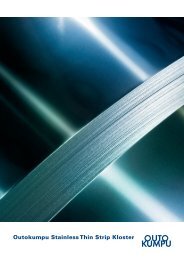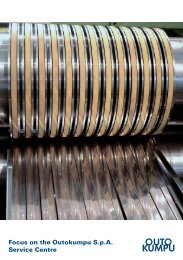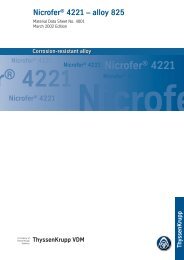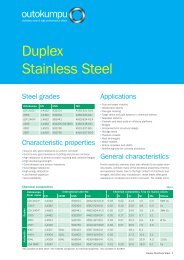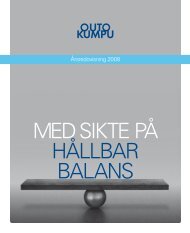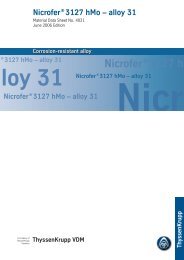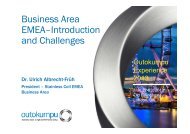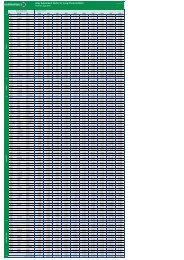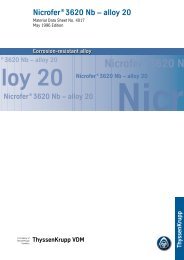Annual Report 2010 - Outokumpu
Annual Report 2010 - Outokumpu
Annual Report 2010 - Outokumpu
You also want an ePaper? Increase the reach of your titles
YUMPU automatically turns print PDFs into web optimized ePapers that Google loves.
201<br />
<strong>Outokumpu</strong> has been systematically developing the Group's operational performance through excellence initiatives, and<br />
a significant number of the company's personnel have been trained to implement related improvement measures in the<br />
company's commercial and production operations. While risks associated with increased input costs are mainly related to<br />
the prices of raw materials and electrical power, other conversion costs such as fuel purchases, freight charges, salaries,<br />
prices for metallurgical coke and the cost of general consumer goods also affect input costs. To mitigate such risks,<br />
<strong>Outokumpu</strong> has developed the Group's purchasing function to improve the management of both purchasing-related and<br />
logistics-related costs. Progress towards excellence in raw materials was also achieved through the company's Supply<br />
Chain Management function in <strong>2010</strong>.<br />
Operational risks<br />
Operational risks include inadequate or failed internal processes, employee actions, systems, or other events such as<br />
natural catastrophes and misconduct/crime. These types of risk are often connected with production operations, logistics,<br />
financial processes, projects or information technology and, should they materialise, can lead to personal injury,<br />
liabilities, loss of property, interrupted operations or environmental impacts. Key operational risks for the Group are a<br />
major fire or accident, security risks, environmental risks, and risks associated with investment projects and company<br />
personnel.<br />
To minimise possible damages to property and business interruptions that could result from fire at some of its major<br />
production sites, <strong>Outokumpu</strong> has instituted systematic fire and security audit programmes. A proportion of such risks is<br />
covered by insurances. Some 30 fire-safety and security audits were carried using the Group's own resources in <strong>2010</strong>,<br />
technical experts from <strong>Outokumpu</strong>'s insurers and insurance brokers often taking part. Development of the Group's<br />
corporate security measures also continued.<br />
<strong>Outokumpu</strong> closely monitors developments in both global and European legislation that may affect Group businesses.<br />
The European Climate and Energy Package (CEP) could have a significant impact on the European electricity market,<br />
and as ferrochrome production in particular consumes large quantities of electrical power could therefore also affect the<br />
Group's business. The risk that a high price for emissions allowances will increase the market price of electricity is<br />
significant, but <strong>Outokumpu</strong>'s stake in the Fennovoima nuclear power project should help in mitigating this. The Group<br />
also attempts to mitigate all types of environment-related risks through systematic risk management and emissions<br />
trading routines, by launching environmental initiatives and by maintaining a proactive dialogue with stakeholders and<br />
parties involved in the framing of environmental legislation.<br />
<strong>Outokumpu</strong>'s objective is to achieve a strong and unified corporate and performance culture throughout the Group.<br />
Developments of this type take time and <strong>Outokumpu</strong>'s ability to achieve financial and other targets could be adversely<br />
affected if progress in related areas is not achieved. Measures to mitigate possible shortcomings include improvements<br />
in productivity and the development of enhanced leadership skills among Group personnel. In <strong>2010</strong>, the focus was on<br />
leadership development through internal programmes and associated training.<br />
During <strong>2010</strong>, a decision was made to restart the project to double <strong>Outokumpu</strong>'s ferrochrome production capacity in the<br />
Kemi/Tornio area in Finland. An investment to increase capability and capacity in the Group's quarto plate production<br />
facility at Degerfors in Sweden was also announced. Failure or delays to implement these projects successfully would<br />
have a negative impact on Group strategy implementation and achievement of financial and growth targets. Actions<br />
taken by <strong>Outokumpu</strong> to manage related risks include the provision of dedicated resources for overall project support.<br />
Financial risks<br />
Key financial risks for <strong>Outokumpu</strong> are: volatility in the nickel, molybdenum and fuel prices; currency risks associated with<br />
the euro, the Swedish krona and the US dollar; limitations on financial flexibility; risks associated with specific a loan<br />
receivable; other credit risks; and liquidity and financing risk. The Group's Financial Risk Policy was reviewed in <strong>2010</strong>,<br />
and some minor changes were introduced including measures related to hedging of fuel costs.<br />
<strong>Outokumpu</strong> <strong>Annual</strong> <strong>Report</strong> <strong>2010</strong> – Financial Statements – Review by the Board of Directors for <strong>2010</strong>




